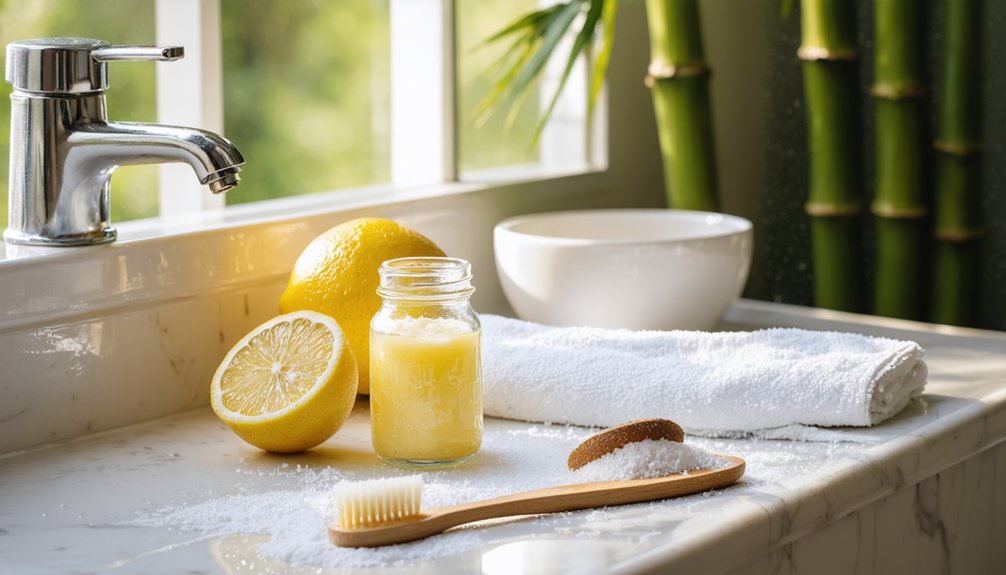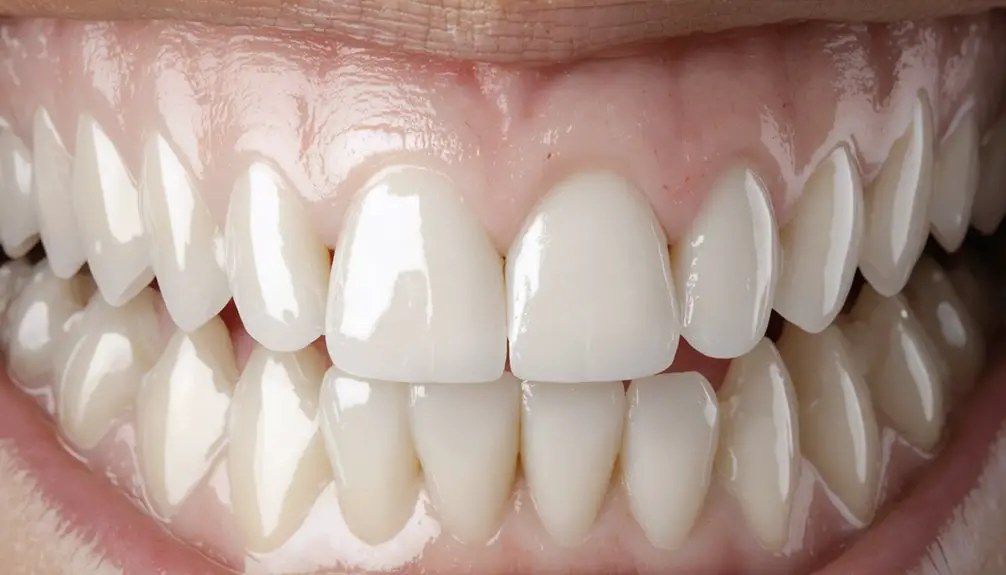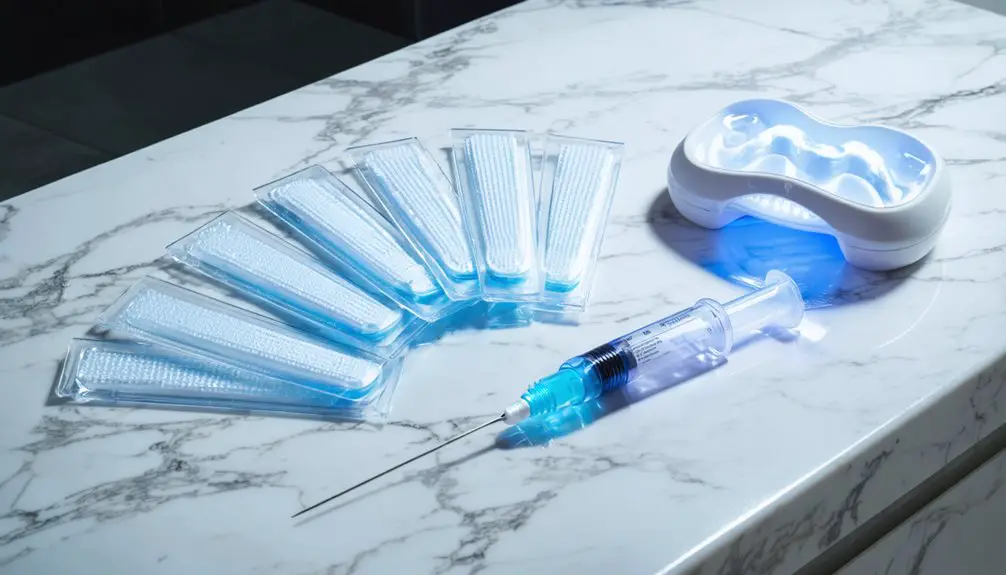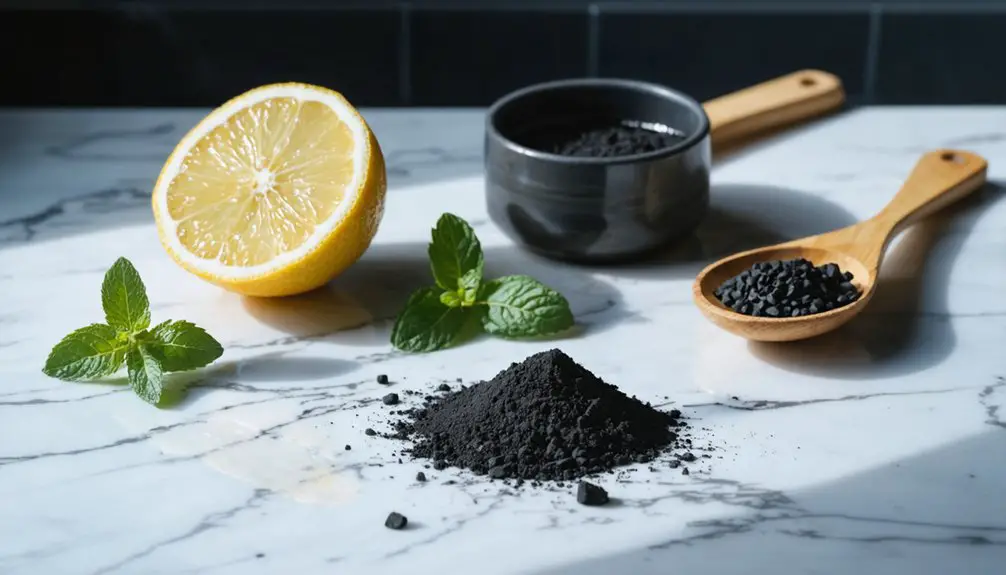You can effectively whiten your teeth at home using proven DIY methods like oil pulling with coconut oil, creating a gentle paste from baking soda and hydrogen peroxide, or incorporating natural whitening foods into your diet. Combine these techniques with proper brushing, flossing, and antimicrobial mouthwash for best results. While these methods work gradually, consistent application of these science-backed techniques will reveal your brightest smile.
Key Takeaways
- Practice oil pulling with coconut oil for 10-20 minutes daily before brushing teeth to reduce stains and kill bacteria.
- Create a natural whitening paste by mixing baking soda and hydrogen peroxide, using it 2-3 times weekly.
- Eat crunchy fruits and vegetables like strawberries and pineapples, which contain natural enzymes that help remove stains.
- Brush twice daily with whitening toothpaste and floss regularly to prevent new stains from forming.
- Apply activated charcoal powder or diluted apple cider vinegar as occasional treatments for surface stain removal.
Natural Oil Pulling Methods for a Brighter Smile
While many people seek expensive dental treatments for whiter teeth, oil pulling offers a natural and cost-effective alternative that’s rooted in ancient Ayurvedic medicine.
Research shows that sesame oil and coconut were the most commonly used oils in clinical trials examining oil pulling’s effectiveness.
You’ll achieve superior results by swishing one tablespoon of coconut oil in your mouth for 10-20 minutes before your morning brushing routine.
Coconut oil’s antimicrobial effects help combat oral bacteria linked to discoloration, while its viscous nature aids in plaque reduction by capturing debris and stains.
Though studies show oil pulling produces milder whitening results compared to peroxide-based treatments, you’ll benefit from its gentle, safe approach without risking tooth sensitivity.
Oil pulling offers a gentler path to whiter teeth, trading dramatic results for a safer approach that won’t leave your teeth sensitive.
The swishing technique requires consistency – practice daily for at least two weeks to notice improvements.
Remember to complement this method with regular brushing and flossing for the best outcome.
Current scientific evidence indicates limited clinical trials exist supporting oil pulling’s effectiveness as a tooth whitening treatment.
The Power of Baking Soda and Hydrogen Peroxide
Beyond oil pulling, one of the most effective DIY teeth whitening methods combines two common household items: baking soda and hydrogen peroxide.
When mixed together, these ingredients create a powerful whitening paste that can lift stains more effectively than either component alone. The mixture works through hydrogen peroxide’s ability to penetrate tooth layers and break down discoloration, while baking soda provides gentle abrasive action. Long-term use of this mixture can increase tooth sensitivity in some people.
To maintain enamel safety, mix 1 tablespoon of baking soda with 2 tablespoons of 3% hydrogen peroxide. Apply this whitening paste gently for one minute, then rinse thoroughly. This natural solution is particularly effective at removing stains from coffee and tea.
Limit applications to 2-3 times weekly to protect your enamel. For best results, use only food-grade baking soda and avoid contact with gums, as hydrogen peroxide can cause tissue irritation.
Dietary Changes That Support Teeth Whitening
Making strategic dietary changes can greatly enhance your teeth whitening efforts and maintain lasting results. Smart fruit choices like strawberries, pineapples, and apples naturally whiten teeth through their unique properties.
Strawberries contain malic acid that breaks down surface stains, while pineapples offer enzymes that dissolve staining proteins. Your drink options also play a vital role – opt for water, green tea, and milk to protect enamel and prevent discoloration. Crunchy vegetables like carrots and celery stimulate saliva production to naturally clean teeth. Proper consumption of fluoridated water helps strengthen teeth while cleansing the mouth.
To maximize whitening results, avoid dark-colored foods and beverages that can stain teeth. Instead, focus on calcium-rich foods like cheese and yogurt to strengthen enamel, and incorporate crunchy vegetables that act as natural cleaners.
After whitening treatments, stick to light-colored foods to protect your investment and maintain that bright smile.
Daily Oral Care Habits That Enhance Whiteness
Proper daily oral care forms the foundation of any successful teeth whitening strategy. You’ll need to brush at least twice daily with a soft-bristled toothbrush and fluoride whitening toothpaste, using gentle motions to protect your enamel. Total Care mouthwash provides excellent antibacterial protection when used properly.
For ideal oral hygiene, combine this with daily flossing to remove stain-causing debris between teeth.
Complete your teeth maintenance routine by rinsing with an alcohol-free antimicrobial mouthwash after brushing and flossing. Stay well-hydrated throughout the day to stimulate saliva production, which naturally cleanses your teeth.
Use a straw when consuming pigmented beverages, and avoid tobacco products that cause stubborn stains. Dark-colored foods like berries and tomato sauce should be enjoyed in moderation to prevent staining.
Remember to schedule professional cleanings every six months to remove surface stains and maintain your results.
Safe Home Remedies for Removing Tooth Stains
Several safe and effective home remedies can help remove tooth stains without harsh chemicals or expensive treatments. When used properly, natural solutions can brighten your smile while protecting your enamel’s integrity.
- Mix baking soda with hydrogen peroxide to create a gentle whitening paste – apply for 2 minutes, no more than twice weekly to prevent enamel erosion. Eating crunchy raw vegetables while chewing thoroughly can help naturally scrub away plaque buildup.
- Practice coconut oil pulling for 15-20 minutes daily to reduce bacteria and plaque buildup while naturally brightening teeth.
- Create a diluted apple cider vinegar rinse for occasional use, followed by thorough water rinsing to neutralize acids.
- Consider activated charcoal applications sparingly, as its mild abrasive action helps remove surface stains, but overuse can damage enamel.
For serious discoloration or significant whitening needs, professional dental treatments provide more dramatic and longer-lasting results than DIY methods.
Always prioritize moderation with these methods to maintain peak dental health while achieving desired whitening results.
Frequently Asked Questions
Can Teeth Whitening Methods Work on Dental Crowns or Veneers?
Like trying to bleach a stone, teeth whitening options won’t change your dental restorations’ color. Your crowns and veneers are made of materials that don’t respond to whitening treatments.
How Long Should I Wait After Whitening Before Consuming Staining Foods?
You’ll need to wait 48 hours after whitening before consuming staining foods to allow your enamel pores to close. During this critical duration, stick to non-staining, light-colored food choices.
Are DIY Whitening Techniques Safe During Pregnancy or While Breastfeeding?
You shouldn’t use DIY whitening techniques during pregnancy due to safety concerns. Instead, focus on natural alternatives like thorough brushing and flossing until after pregnancy or breastfeeding when treatments become safer.
What Age Is Appropriate to Start Using Teeth Whitening Methods?
Like getting your first iPhone, teeth whitening should wait until you’re at least 13-14 due to teenage sensitivity issues. Consult dental advice first, as professional supervision’s recommended until age 16-17.
Can Whitening Treatments Make Existing Dental Fillings Appear More Noticeable?
Yes, whitening treatments won’t affect your fillings’ color, leading to potential cosmetic concerns. Your natural teeth will lighten while fillings remain unchanged, making filling discoloration more noticeable against your brighter smile.
References
- https://www.pleasantfamilydentistry.com/blog/6-natural-ways-to-whiten-your-teeth
- https://www.healthline.com/nutrition/whiten-teeth-naturally
- https://www.listerine.com/teeth-whitening/whitening-teeth-instructions
- https://www.goodhousekeeping.com/health-products/g28723133/best-at-home-teeth-whitening-products/
- https://www.medicalnewstoday.com/articles/322421
- https://www.urmc.rochester.edu/news/publications/health-matters/diy-teeth-whitening-too-good-to-be-true
- https://www.sandiegoartofdentistry.com/blog/what-is-the-best-teeth-whitening-method/
- https://www.youtube.com/watch?v=TuWhJmF0FF8
- https://chestnutdental.com/blog/are-natural-teeth-whitening-methods-safe-and-effective/
- https://journals.sagepub.com/doi/pdf/10.1177/2229411220160104



